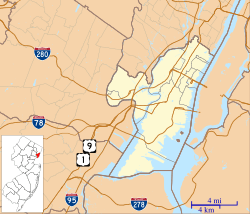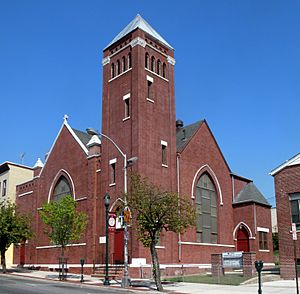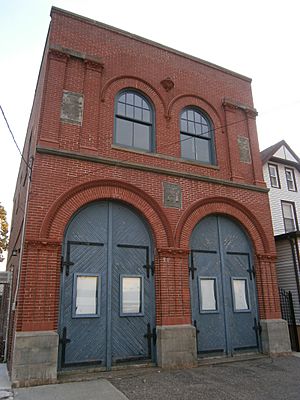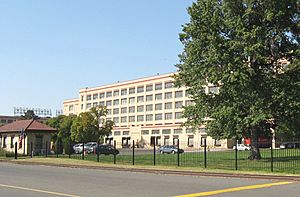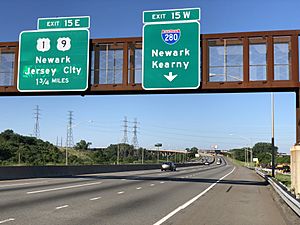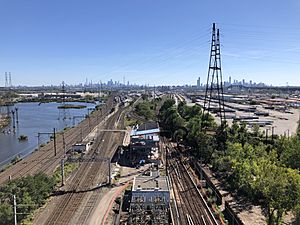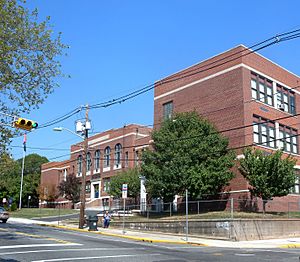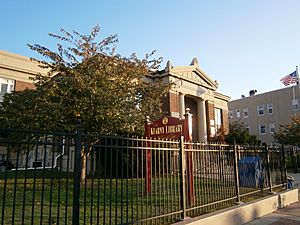Kearny, New Jersey facts for kids
Quick facts for kids
Kearny, New Jersey
|
|
|---|---|
|
Town
|
|
| Town of Kearny | |

Kearny Generating Station
|
|
| Nickname(s):
Soccer Town, U.S.A.
|
|

Location of Kearny within Hudson County and the state of New Jersey
|
|

Census Bureau map of Kearny, New Jersey
|
|
| Country | |
| State | |
| County | |
| Incorporated | April 8, 1867 |
| Named for | Philip Kearny |
| Government | |
| • Type | Town |
| • Body | Town Council |
| Area | |
| • Total | 10.27 sq mi (26.61 km2) |
| • Land | 8.84 sq mi (22.91 km2) |
| • Water | 1.43 sq mi (3.70 km2) 13.91% |
| Area rank | 209th of 565 in state 3rd of 12 in county |
| Elevation | 7 ft (2 m) |
| Population | |
| • Total | 40,684 |
| • Estimate
(2019)
|
41,058 |
| • Rank | 51st of 566 in state 7th of 12 in county |
| • Density | 4,636.5/sq mi (1,790.2/km2) |
| • Density rank | 122nd of 566 in state 11th of 12 in county |
| Time zone | UTC−05:00 (Eastern (EST)) |
| • Summer (DST) | UTC−04:00 (Eastern (EDT)) |
| ZIP Codes |
07032, 07099
|
| Area code(s) | 201 and 973 |
| FIPS code | 3401736510 |
| GNIS feature ID | 0885266 |
Kearny ( KAR-nee) is a town in the western part of Hudson County, New Jersey, United States and a suburb of Newark. As of the 2010 United States Census, the town's population was 40,684, reflecting an increase of 171 (+0.4%) from the 40,513 counted in the 2000 Census, which had in turn increased by 5,639 (+16.2%) from the 34,874 counted in the 1990 Census.
Kearny is named after Civil War general Philip Kearny. It began as a township formed by an act of the New Jersey Legislature on April 8, 1867, from portions of Harrison Township. Portions of the township were taken on July 3, 1895, to form East Newark. Kearny was incorporated as a town on January 19, 1899, based on the results of a referendum held two days earlier. The Arlington section of town was named for Arlington Station on the Erie Railroad at the Arlington Mill plant, owned by Arlington Mills of Lawrence, Massachusetts.
Contents
History
Colonial roots
The area of Kearny Township, created in 1867, had been part of the original Crown Grant of 30,000 acres (120 km2) obtained by Major William Sandford of Barbados on July 4, 1668. Major Sandford named it New Barbadoes Neck after his old home. As was the custom of the time, the Major paid 20 pounds sterling to Chief Tantaqua of the Hackensack tribe for all their reserve rights and titles.
Sanford's friend Major Nathaniel Kingsland acquired the property in 1708 and sold the upper western tract of the Grant for 300 pounds sterling to Captain Arent Schuyler two years later. The new purchase included present-day Kearny, North Arlington, Lyndhurst and Kingsland.
Shortly after Schuyler's purchase of his new homestead, a peculiar green stone was uncovered. It was sent to England for analysis and he learned that it contained 80% copper. His opening of a copper mine brought the first steam engine to America from England; it was used to pump out the deep mine shaft. The engine was secretly delivered by its engineer, Josiah Hornblower. The engine and mines were destroyed by fire in 1772 and remained idle for some years.
Schuyler Mansion played a role during the American Revolutionary War Era. When Lord Howe of England took possession of New York Harbor, the proximity of Schuyler Mansion drew many of his officers. They generally traveled over a road that today is referred to as the Belleville Turnpike, which was originally constructed in 1759 using cedar logs from the nearby swamps.
During September 1777, General Henry Clinton, head of the British Expeditionary Forces in America, selected Schuyler Mansion for his headquarters during one of his more important raiding operations which included the famed Battle of Second River. The Mansion stood until 1924, a period of 214 years, when it was torn down by a land development company, despite the company's offers to transfer the land an organization that would be able to pay to maintain the property.
19th century
In the middle 19th century, Kearny was the upper, or northern, section of the Township of Harrison. A prominent citizen and resident of the upper section, General N. M. Halsted, felt it was impossible under these political conditions for his section to obtain proper recognition. He engaged an energetic campaign for an independent township. He succeeded when the NJ Legislature of 1867 on March 14, adopted "an act creating the Township of Kearny". The town was named to honor Major General Phil Kearny, Commander of the New Jersey Forces in the Civil War and the owner of the mansion known as Belle Grove (or Belgrove), locally called "Kearny Castle".
On April 8, 1867, the first election of town officers was held. General N. M. Halsted was elected Chairman. The first official seat of Government was three rooms in the old Lodi Hotel, on the northeast corner of Schuyler and Harrison Avenues.
In the early 1870s, Kearny erected its first Town Hall, on the corner of Kearny and Woodland Avenues, the present site of the Knox Presbyterian Church Parish Hall. This served as a Town Hall, Court House, and Schoolhouse. The Minute Book of the Township states on August 16, 1870, the first step toward establishing Kearny's present public school system was taken. The first schoolhouse was housed in the Town Hall built at Kearny and Woodland Avenues in 1873.
The Highland Hose No. 4 firehouse which is now on the National Register of Historic Places list was built in 1895.
The town's nickname, "Soccer Town, U.S.A." is derived from a soccer tradition that originated in the mid-1870s, when thousands of Scottish and Irish immigrants settled in the town, after two Scottish companies, Clark Thread Company and Nairn Linoleum, opened two local mills and a factory.
When the town's growth demanded larger quarters, the present Kearny Town Hall, built of Indiana limestone, was erected in 1909.
Factory town
The early influx and development of industry in Kearny dates back to 1875 when the Clark Thread Company of Paisley in Scotland extended its activities to the United States by erecting two large mills in Kearny, and adding two others in 1890. These mills brought to Kearny thousands of Scots immigrants. Many of them would play on Kearny's soccer teams in National Association Football League. Many are buried at Arlington Memorial Park in the Kearny Uplands.
In 1876, the Mile End Thread Mills started operating, giving employment to several hundred operators.
In 1883, the Marshall Flax Spinning Company of England erected a large plant in Kearny, known as the Linen Thread Company. Their need for experienced flax spinners brought an influx of workers from other sections of the British Isles. Families of those early textile workers were the nucleus of Kearny's present population.
The Puraline Manufacturing Company, later called the Arlington Company, which became a subsidiary of E. I. DuPont de Nemours Company, had purchased a large tract of land east of the Arlington Station on the Erie Railroad extending well out, north of the railroad embankment, into the meadowland.
In 1887, Sir Michael Nairn established the Nairn Linoleum Company of Kirkcaldy in Scotland, now the Congoleum Nairn Company of Kearny, giving further impetus to local industrial growth. This also lead to the growth in the Scottish American population which In the 1960s was about 21,000.
In 1902, the Lovell–Dressel Company, manufacturers of marine and railway lamps and fixtures, located in Kearny adjacent to the Erie Railroad.
Other industries which located in Kearny include: Swift & Company, Koppers Company, Theobald Industries, Standard Tool & Manufacturing, Wilkata Box Company, Harris Steel Company and L & R Manufacturing. Between 1926 and 1986, the Kearny Works of Western Electric employed as many as 24,000 in producing a variety of hardware and supplies for the Bell System and was the home of the "Kearny Standard" for tools and equipment, and was sold by AT&T in 1984 by which time the plant had 4,000 employees who earned a total of $128 million a year, making it one of the county's largest employers.
Cargo ships were built at Kearny Yards during World War I, and warships during World War II.
21st century
The HBO drama series The Sopranos was filmed partially in Kearny. One of its buildings, used for Satriale's Pork Store, was later razed to prepare for a condominium development.
Geography
According to the United States Census Bureau, the town had a total area of 10.193 square miles (26.399 km2), including 8.775 square miles (22.726 km2) of land and 1.418 square miles (3.673 km2) of water (13.91%).
Unincorporated communities, localities and place names located partially or completely within the town include Arlington, Schuylers Corner and West Arlington.
The town is bordered by East Newark, Harrison and North Arlington (which is located in Bergen County). The Passaic River separates the town from Newark and Belleville, both located in Essex County. The Hackensack River separates it from Jersey City.
The town is varied in topography and roughly divided into three parts: the Kearny Uplands, the Kearny Meadows and Kearny Point. Main thoroughfares include the eponymous Kearny Avenue (the local segment of Ridge Road / Frank E. Rodgers Boulevard), Bergen Avenue, Midland Avenue, Schuyler Avenue and Passaic Avenue. The unincorporated community of Arlington is located within the town.
A number of small parks running along Passaic River are collectively called Riverbank Park. The largest, located on the colloquial "Bunnyland Hill", is a gift from Kearny's veterans. It is named after a small zoo named Bunnyland, which was maintained by the local Kiwanis Club, that occupied part of the present Bunnyland Hill in the 20th century. During Kearny's Fourth of July celebrations (which include a fireworks display), Bunnyland Hill is the primary gathering spot for celebrants and observers. The largest park is West Hudson Park, shared with Harrison, which contains a variety of sports fields, recreational areas, and an artificial pond. The second largest recreational zone is the Kearny Playground at Gunnel Oval.
Demographics
| Historical population | |||
|---|---|---|---|
| Census | Pop. | %± | |
| 1880 | 777 | — | |
| 1890 | 7,064 | 809.1% | |
| 1900 | 10,896 | 54.2% | |
| 1910 | 18,659 | 71.2% | |
| 1920 | 26,724 | 43.2% | |
| 1930 | 40,716 | 52.4% | |
| 1940 | 39,467 | −3.1% | |
| 1950 | 39,952 | 1.2% | |
| 1960 | 37,472 | −6.2% | |
| 1970 | 37,585 | 0.3% | |
| 1980 | 35,735 | −4.9% | |
| 1990 | 34,874 | −2.4% | |
| 2000 | 40,513 | 16.2% | |
| 2010 | 40,684 | 0.4% | |
| 2019 (est.) | 41,058 | 0.9% | |
| Population sources: 1880–1920 1880–1890 1890–1910 1900–1930 1930–1990 2000 2010 |
|||
Census 2010
As of the census of 2010, there were 40,684 people, 13,462 households, and 9,921 families residing in the town. The population density was 4,636.5 per square mile (1,790.2/km2). There were 14,180 housing units at an average density of 1,616.0 per square mile (623.9/km2)*. The racial makeup of the town was 73.57% (29,933) White, 5.37% (2,186) Black or African American, 0.40% (163) Native American, 4.41% (1,793) Asian, 0.08% (32) Pacific Islander, 12.53% (5,099) from other races, and 3.63% (1,478) from two or more races. [[Hispanic (U.S. Census)|Hispanic or Latino of any race were 39.95% (16,253) of the population.
There were 13,462 households out of which 33.5% had children under the age of 18 living with them, 51.6% were married couples living together, 15.6% had a female householder with no husband present, and 26.3% were non-families. 21.0% of all households were made up of individuals, and 7.7% had someone living alone who was 65 years of age or older. The average household size was 2.83 and the average family size was 3.28.
In the town, the population was spread out with 20.7% under the age of 18, 11.0% from 18 to 24, 31.2% from 25 to 44, 26.4% from 45 to 64, and 10.7% who were 65 years of age or older. The median age was 36.4 years. For every 100 females there were 106.0 males. For every 100 females ages 18 and old there were 105.7 males.
The Census Bureau's 2006–2010 American Community Survey showed that (in 2010 inflation-adjusted dollars) median household income was $58,698 (with a margin of error of ±$3,838) and the median family income was $66,272 (±$3,803). Males had a median income of $45,360 (±$2,598) versus $38,668 (±$3,893) for females. The per capita income for the borough was $24,977 (±$1,022). About 7.6% of families and 10.3% of the population were below the poverty line, including 14.2% of those under age 18 and 8.1% of those age 65 or over.
Census 2000
As of the 2000 United States Census there were 40,513 people, 13,539 households, and 9,802 families residing in the town. The population density was 4,433.2 people per square mile (1,711.4/km2). There were 13,872 housing units at an average density of 1,518.0 per square mile (586.0/km2). The racial makeup of the town was 75.75% White, 3.97% African American, 0.37% Native American, 5.50% Asian, 0.07% Pacific Islander, 10.04% from other races, and 4.31% from two or more races. Hispanic or Latino of any race were 27.34% of the population.
There were 13,539 households, out of which 34.6% had children under the age of 18 living with them, 53.8% were married couples living together, 13.2% had a female householder with no husband present, and 27.6% were non-families. 21.8% of all households were made up of individuals, and 8.8% had someone living alone who was 65 years of age or older. The average household size was 2.81 and the average family size was 3.28.
In the town, the population was spread out, with 21.5% under the age of 18, 10.7% from 18 to 24, 35.7% from 25 to 44, 21.3% from 45 to 64, and 10.9% who were 65 years of age or older. The median age was 35 years. For every 100 females, there were 106.6 males. For every 100 females age 18 and over, there were 107.0 males.
The median income for a household in the town was $47,757, and the median income for a family was $54,596. Males had a median income of $38,672 versus $30,620 for females. The per capita income for the town was $20,886. About 6.1% of families and 8.6% of the population were below the poverty line, including 9.1% of those under age 18 and 10.0% of those age 65 or over.
Transportation
Roads and highways
As of May 2010[update], the town had a total of 70.89 miles (114.09 km) of roadways, of which 50.75 miles (81.67 km) were maintained by the municipality, 7.30 miles (11.75 km) by Hudson County, 7.73 miles (12.44 km) by the New Jersey Department of Transportation and 5.11 miles (8.22 km) by the New Jersey Turnpike Authority.
The Belleville Turnpike (Route 7) forms the northern border of the town with North Arlington and crosses the Rutgers Street Bridge over the Passaic River into Belleville. Kearny Avenue passes through the town and continues north as Ridge Road, the beginning of Route 17. U.S. Route 1/9 (Pulaski Skyway) and US 1/9 Truck pass through. The Essex Freeway (Interstate 280) passes through the town and ends at Interstate 95(W) (the New Jersey Turnpike eastern and western spurs) at the tollgate for Exit 15W.
Public transportation
NJ Transit offers bus service to the Port Authority Bus Terminal in Midtown Manhattan and to other New Jersey communities. Bus service to Newark is available on the 1, 30, 40, and 76 routes.
Kearny was formerly served by trains of both the Erie Railroad's Newark Branch (later Erie-Lackawanna and then Conrail's Newark Industrial Branch) and its Greenwood Lake Division (later the Erie-Lackawanna's Greenwood Lake-Boonton Line; and Conrail and New Jersey Transit's Boonton Line) which stopped at the now-abandoned Arlington station. Newark Branch passenger service was terminated in October, 1966. But freight service continued until 2005, when the last remaining shipper, Spar-Tech PolyCom, shut down. However freight service on the Newark side is still active. New Jersey Transit discontinued Boonton Line service in 2002 when the Montclair Connection was opened. Through the early 1970s trains also stopped at a second station along this route known as West Arlington. This station was just to the east of the now abandoned WR Draw movable bridge. Prior to April 30, 1967, a station in South Kearny, was served by the Central Railroad of New Jersey's Newark and New York Railroad via the PD Draw over the Passaic River. This station was popular with employees of the giant Western Electric plant, and other industries in the area. In the final years of this service a pair of rush hour trains ran in each direction between South Kearny, and the CNJ's Broad Street Station in downtown Newark, as well as a single rush hour round trip between South Kearny, and Plainfield. This train operated via Elizabethport, and the CNJ main line. Kearny is also the location of the Meadows Maintenance Complex, the primary maintenance facility for NJ Transit rail operations.
The closest airport with scheduled passenger service is Newark Liberty International Airport, located 6.5 miles (10.5 km) away in Newark and Elizabeth.
Economy
Portions of the town are part of an Urban Enterprise Zone (UEZ), one of 32 zones covering 37 municipalities statewide. Kearny was selected in 1983 as one of the initial group of 10 zones chosen to participate in the program. In addition to other benefits to encourage employment and investment within the Zone, shoppers can take advantage of a reduced 3.3125% sales tax rate (half of the 6+5⁄8% rate charged statewide) at eligible merchants. Established in November 1992, the town's Urban Enterprise Zone status expires in November 2023. Since its inception, there has been $27 million in tax revenue that has been invested based on revenue from the Urban Enterprise Zone.
Education
Public Schools
The Kearny School District serves public school students in pre-kindergarten through twelfth grade. As of the 2017-18 school year, the district and its seven schools had an enrollment of 5,619 students and 441.2 classroom teachers (on an FTE basis), for a student–teacher ratio of 12.7:1. Schools in the district (with 2017-18 enrollment data from the National Center for Education Statistics) are Franklin School (955 students; in PreK-6), Garfield School (525; PreK-6), Roosevelt School (437; PreK-6), Schuyler School (454; PreK-6), Washington School (559; PreK-6), Lincoln Middle School (910; 7-8) and Kearny High School (1,731; 9-12).
Private schools
Schools in Kearny include:
- Kearny Christian Academy, a Christian school founded in 1981 by the City of Hope International Church that serves students in kindergarten through twelfth grade.
- Mt. Carmel Guild School
- The Little Neighborhood Learning Center
- Happy Time Preschool & Day Care
In the face of declining enrollment, the Roman Catholic Archdiocese of Newark closed Mater Dei Academy at the conclusion of the 2011–12 school year. Mater Dei had been opened three years earlier as the merger of two existing schools, St. Stephen's and Holy Cross (the latter in Harrison), but attendance declined from 250 in its first year to 170 in its final year. Other former Catholic schools in Kearny include: Sacred Heart School and St. Cecilia School.
Library and museum
The Kearny Public Library is one of New Jersey's remaining Carnegie libraries, and houses a museum on its third floor which mounts exhibitions related to the history and culture of the town and has a collection of artifacts related to the town's namesake.
Notable people
People who were born in, residents of, or otherwise closely associated with Kearny include:
- Tomasz Adamek (born 1976), Polish professional heavyweight boxer who is the former WBC Light Heavyweight Champion and the former IBF & IBO & The Ring Cruiserweight Champion.
- Karen Akunowicz (born 1978), award-winning chef, Top Chef contestant.
- Marcello Borges (born 1997), soccer player who currently plays college soccer at the University of Michigan.
- Rachel Breton (born 1990), soccer striker and defender who played for Sky Blue FC and New Jersey Wildcats.
- Davey Brown (1898–1970), U.S. soccer forward who was inducted into the US Soccer Hall of Fame.
- Marques Brownlee (born 1993) YouTube personality who reviews technology.
- Guy W. Calissi (c. 1909–1980), New Jersey Superior Court judge who lived in an orphanage here.
- Gary Michael Cappetta (born 1952), professional wrestling ring announcer, author, voice over artist, screenwriter and stage performer.
- Ownie Carroll (1902–1975), Major League Baseball pitcher who played nine seasons in the major, from 1925 to 1934 .
- Ted Gillen (born 1968), former professional soccer player.
- Ed Halicki (born 1950), former professional baseball pitcher with a no-hitter to his credit, pitched on August 24, 1975, against the New York Mets.
- John Harkes (born 1967), professional soccer player.
- Al Hartley (1921–2003), comic book writer-artist known for his work on Archie Comics.
- Fred A. Hartley Jr. (1909–1969), New Jersey Congressman best known for being the House of Representatives sponsor of the Taft-Hartley Act.
- Herbie Haymer (1916–1949), jazz saxophonist.
- Frank Iero (born 1981), rhythm guitarist and backup vocalist for My Chemical Romance.
- James F. Kelley (1902–1996), President of Seton Hall College (since renamed as Seton Hall University) from 1936 to 1949.
- Jeffrey Klepacki (born 1968), three-time US Olympian in rowing and three-time world champion.
- Buzz Kulik (1922–1999), film director and producer.
- Joe Kyrillos (born 1960), politician who served in the New Jersey Senate from 1992 to 2018, where he represents the 13th Legislative District.
- Joan Lippincott (born 1935), concert organist.
- Monroe Jay Lustbader (1931-1996), politician who served in the New Jersey General Assembly from 1992 until his death, where he represented the 21st Legislative District.
- Kevin Maguire (born 1960), comic book artist.
- Paul McCurrie (1929–2020), lawyer and politician who served in the New Jersey General Assembly.
- Tony Meola (born 1969), professional soccer player.
- Dots Miller (1886–1923), Major League Baseball player from 1909 to 1921.
- Michael Moran (born 1962), author / analyst of international affairs and digital documentarian.
- Tony Mottola (1918–2004), jazz guitarist.
- Shamus O'Brien (1907–1981), soccer player inducted in 1990 into the National Soccer Hall of Fame.
- Hugh O'Neill (born 1954), soccer player who played in the NASL, ASL, and MISL.
- Greg Pason (born 1966), National Secretary of the Socialist Party USA.
- George Paxton (c. 1914–1989), big band jazz leader, saxophonist, composer and producer.
- Matt Pelissier (born 1979), Drummer for My Chemical Romance
- Bill Raftery (born 1943), college basketball analyst and former college basketball player for La Salle University.
- Tab Ramos (born 1966), retired soccer midfielder.
- James H. Rupp (1918-1998), Illinois state senator, Mayor of Monmouth, Illinois, and businessman
- Harold Hill Smith (1910–1994), geneticist who first fused a human cell and a plant cell.
- Bob Stanley (born 1954), professional baseball relief pitcher who played for the Boston Red Sox.
- Archie Stark (1897–1985), soccer pioneer in the United States and member of the National Soccer Hall of Fame.
- Ray Toro (born 1977), My Chemical Romance lead guitarist.
- John Patrick Washington (1908–1943), Roman Catholic priest; one of the Four Chaplains, who gave their lives to save other soldiers during the sinking of the troop transport Dorchester during World War II.
- Alex Webster (1931-2012), fullback and halfback in the National Football League for the New York Giants, who was later head coach of the Giants from 1969 to 1973.
- Dick Weisgerber (1915-1984), professional football player for the Green Bay Packers.
- Kenneth G. Wiman (born 1930), U.S. Coast Guard Rear Admiral.
See also
 In Spanish: Kearny (Nueva Jersey) para niños
In Spanish: Kearny (Nueva Jersey) para niños


